August 2014
July 2014 Newsbytes archive
Posted by crossaffliction on Fri 1 Aug 2014 - 00:34Contributors this month include crossaffliction, dronon, earthfurst, Fred, GreenReaper, InkyCrow, Patch Packrat, Rakuen Growlithe and RingtailedFox.
Review: 'The Northern Approach', by Jim Galford
Posted by Fred on Sun 3 Aug 2014 - 18:16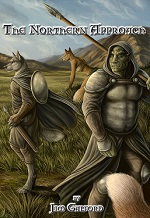 This is book 4 of The Fall of Eldvar by Jim Galford. I reviewed book 1, In Wilder Lands, here in March 2012; book 2, Into the Desert Wilds, in November 2012, and book 3, Sunset of Lantonne, in February 2014.
This is book 4 of The Fall of Eldvar by Jim Galford. I reviewed book 1, In Wilder Lands, here in March 2012; book 2, Into the Desert Wilds, in November 2012, and book 3, Sunset of Lantonne, in February 2014.
The first two are a two-part subseries, “the wilding story arc”, within the larger saga of The Fall of Eldvar. Sunset of Lantonne is a standalone adventure. The Northern Approach, which debuts at Rocky Mountain Fur Con 2014 this month, continues roughly where both Sunset of Lantonne and Into the Desert Wilds end. The planned book 5, Bones of the Empire, will wrap up and complete the series.
What this means is that it is assumed the reader is familiar with the events in at least Sunset of Lantonne. The Northern Approach begins almost a year after the fall of Lantonne at its climax; but in terms of the action it follows immediately, without any synopsis.
Eldvar is a world of humans, elves, dwarfs, talking dragons and more, including wildings which are anthropomorphic animals. The story’s focus on the wildings is why the novels of The Fall of Eldvar qualify for review on Flayrah.
Seattle, WA, CreateSpace, August 2014, trade paperback $13.99 (432 pages), Kindle $2.99.
A completely biased review of 'The Guardians of the Galaxy'
Posted by crossaffliction on Sun 3 Aug 2014 - 22:23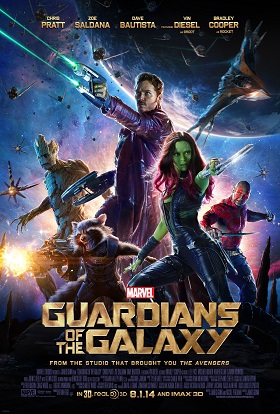 So, there was recently an article on Flayrah I can’t link to anymore since the author asked it be removed, but the general gist of it was that bias in criticism is bad. Not going to argue that point one way or another, but argue a side tangent; the article never really said so, but the argument the author was really making was that negative bias is bad. Positive bias is either okay, or just doesn’t exist.
So, there was recently an article on Flayrah I can’t link to anymore since the author asked it be removed, but the general gist of it was that bias in criticism is bad. Not going to argue that point one way or another, but argue a side tangent; the article never really said so, but the argument the author was really making was that negative bias is bad. Positive bias is either okay, or just doesn’t exist.
I don’t like onions, so I would be a terrible person to ask if an onion is good or not. However, if you liked onions, and they were your favorite food, you would also be a terrible person to ask for a review of a particular onion. I would say this onion is bad, because to me, all onions are bad. You would say this onion is good, because to you, all onions are good. Together, our reviews of the onion have told us nothing about this particular onion.
In case you haven’t noticed, I’ve been waiting for this movie a while; you could say I’m biased for it. So, by my very argument, I am unqualified to review this movie. I’m going to do it anyway, because I can, and besides, if one person has a bias, the odds are that many other people share the same bias.
Besides, this isn’t my first rodeo; I know what I’m doing, and believe I am capable of looking past my biases and giving this movie a fair review. Not like it can complain; I’m going to say this movie is awesome, after all.
But, fair warning; this is a biased review. Also, never ask me to review an onion.
Review: 'The Adventures of Nilson Groundthumper and Hermy', by Stan Sakai
Posted by Fred on Mon 4 Aug 2014 - 03:30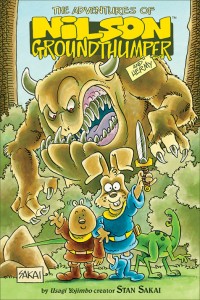 This is a collection of all twelve of Stan Sakai’s Nilson Groundthumper comic-art short stories, in an attractive hardcover full-color “graphic novel” format.
This is a collection of all twelve of Stan Sakai’s Nilson Groundthumper comic-art short stories, in an attractive hardcover full-color “graphic novel” format.
Sakai is most famous for his ongoing series about Miyamoto Usagi, the rabbit ronin in the early 1600s Tokugawa shogunate in an anthropomorphized-animal Japan.
Most people who know about Sakai’s Nilson Groundthumper series think of it as Sakai’s series just before the adventures of Usagi Yojimbo, but they were actually mostly contemporaneous. The first Nilson short story was published in Albedo: Anthropomorphics #1 in 1984; the first Usagi story was in Albedo #2.
The two alternated briefly, then Sakai concentrated on Usagi Yojimbo with an occasional Nilson story as a backup feature, or when Sakai wanted to do a standalone short story for a different magazine. Most of these were first published between 1985 and 1994, with a final story in 2013.
Milwaukie, OR, Dark Horse Books, March 2014, hardcover $14.99 (109 [+3] pages).
Review: 'My Little Pony: Friendship is Magic' Keys of Friendship DVD (with bonus 'Rainbow Rocks' trailer)
Posted by crossaffliction on Tue 5 Aug 2014 - 01:48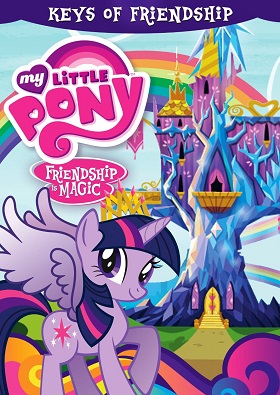 “The smell of acrid smoke and horses’ breath …”
“The smell of acrid smoke and horses’ breath …”
- Iron Maiden, “The Trooper”
The good folks behind My Little Pony: Friendship is Magic decided that what this show needs is season long story arcs. All the cool shows are doing it now. This DVD tries to collect the first real season long story arc, from season 4 of the show, and pretty much fails spectacularly to do that.
Technically, this story arc contains the two part opener for the fourth season, “Princess Twilight Sparkle” parts one and two, in which the ponies realize they need to be looking for six keys to unlock a magic box that a tree just grew. Wow, that sentence doesn’t make any sense whatsoever, but I swear, it’s what happened. Those two episodes are not featured here.
Then, five of the ponies have individual adventures, where they help someone out in a way that relates to their special Element of Harmony, beginning with Rarity and ending with Applejack, because Applejack always goes last. Two of those episodes are collected here, featuring Rarity and Fluttershy. Rainbow Dash’s episode is featured on another DVD I haven’t reviewed yet, and Applejack and Pinkie Pie are waiting for future DVD releases, despite the fact that Pinkie has the best by a long shot.
Finally, we have the season four finale, where the box is opened when Twilight Sparkle finally figures out how to get her key, amongst other things, and, I guess, “Castle-Mania” technically features Twilight trying and failing to research the box, so 10 out of 26 episodes. I don’t think we can call the other 16 episodes filler when they so outnumber the “arc” episodes, and they’re usually better anyway.
Review: 'Evolutionary Action', by Phil Geusz
Posted by Fred on Tue 5 Aug 2014 - 15:46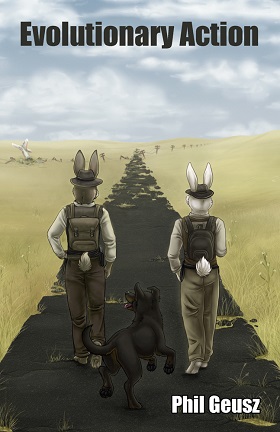 Phil Geusz is famous in furry fandom for his fiction featuring genengineered anthro-rabbits. They are usually highly intellectual and non-violent. This makes the beginning of Evolutionary Action rather startling: Dr. Rusty Harrison, a professor of “the University” and a personal friend of the dean, is complaining about the mess in his brown fur that killing two assassins at close range has made.
Phil Geusz is famous in furry fandom for his fiction featuring genengineered anthro-rabbits. They are usually highly intellectual and non-violent. This makes the beginning of Evolutionary Action rather startling: Dr. Rusty Harrison, a professor of “the University” and a personal friend of the dean, is complaining about the mess in his brown fur that killing two assassins at close range has made.
I wrung out my sponge. There was a nasty bit of scalp lodged in it, and I didn’t want to get hair all over the place. I used hollowpoints in my .357, and the explosive effect tended toward the spectacular at close range. The least I could do for poor Alice was stick around and help with the cleanup. Even if I was working nasty little balls of coagulating blood so deep into my pelt that I’d have to soak for hours to get them out. I counted Alice as a friend, after all. (p. 5)
This is one of those novels that is difficult to summarize without giving away spoilers. Over 99% of mankind has died in the catastrophe known as the Breakdown, the Plague, the Collapse or the Outbreak, and the survivors are struggling to keep up some form of civilization. There are not enough to maintain the United States of America, and it has broken apart into many tiny independent state-based countries like the West Coast Confederation, the Sooner Republic, the Colorado Republic, Iowssouri, the Arkansas Free State, the Lone Star Republic and so on. Most of them are friendly and trying to maintain good relations with each other, but at least one is out for a war of conquest against the others, executing the governments of the conquered states.
The University, which was experimenting with genengineering before the Breakdown, has all of the intelligent Rabbits left in the world, and is one of the remaining practitioners of research. It is a politically independent enclave located in the Sooner Republic, which supports it. However, the armies of one of the aggressors are approaching the Sooners and neighboring Texas, and both the Sooner and Lone Star governments and the University administration are wondering what to do.
Dallas, TX, FurPlanet Productions, September 2013, trade paperback $9.95 (187 pages).
Review: 'Teenage Mutant Ninja Turtles' Enter Shredder DVD
Posted by crossaffliction on Tue 5 Aug 2014 - 16:00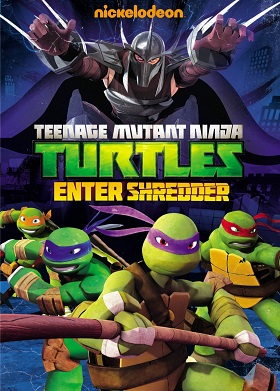 Unlike some other animated television series that will remain unnamed in this review, the newest animated incarnation of Teenage Mutant Ninja Turtles is releasing DVDs that feature the episodes in order at regular intervals, approximately six at a time.
Unlike some other animated television series that will remain unnamed in this review, the newest animated incarnation of Teenage Mutant Ninja Turtles is releasing DVDs that feature the episodes in order at regular intervals, approximately six at a time.
The upshot is that I can review each episode in order by nominally reviewing the DVDs; at this point, I can review all the way through the approximate first quarter of the second season from Nickelodeon. So I’m going to do that. Starting right now.
The Episodes
“Monkey Brains”
It probably says something that, despite introducing a new mutant in this episode, said mutant didn’t manage to even gain his own action figure. And this is TMNT we’re talking about; in the original animated series, the action figure came first half the time, then the episode (if at all). He doesn’t even have a mutant name; he’s just his old human name, Dr. Rockwell, or “the monkey” (despite technically being an ape). Monkeys and apes just aren’t very charismatic as anthros, especially when they can’t even talk.
However, it does introduce a recurring villain, Dr. Falco (who will eventually get an action figure under a different name, and is voiced by Jeffrey The Reanimator Combs) and the idea that April will begin training as a kunoichi under Splinter. And the main “lesson” of the episode, in which overthinking Donatello must learn to fight more instinctively against a villain who can read his thoughts, is a good character-based plot engine; his flowchart for hanging out with April is an amusing subplot.
Review: 'Fuzzy Business' and 'Fuzzy Business 2: Fuzz Harder', by Amelia Ritner
Posted by Fred on Wed 6 Aug 2014 - 01:22
Miara is a humanimal, a woman just like anyone else, except with feline features and some feline abilities … (blurb)
I cannot help remembering A.I.P.’s July 1977 movie of The Island of Dr. Moreau, with Burt Lancaster as Dr. Paul Moreau, the Mad Scientist who was uplifting animals into humanimals™, and downlifting humans into humanimals™. I don’t think that A.I.P. put out a single bit of publicity without emphasizing that humanimals™ was its own trademarked word. Fortunately, A.I.P. is gone now, and its trademark doubtlessly expired long ago.
Miara Cooper is a cat-girl.
I am mostly human, of course. I walk upright, have two breasts, and wear clothing. But it is impossible not to notice the domestic feline in my appearance. My eyes are green and my pupils are vertical instead of rounded, at least in the daylight. My pointed, hairy ears are on top of my head. My nose is small, upturned and moist. I have a small set of whiskers at the corners of my upper lip; just a little less than would make me look like one of those Chinamen in an old Looney Tunes cartoon. My skin is white, but it is barely visible under thick, dark hair. At least the hair is human-like: fine and light brown.Just longer and thicker than most human women have on the rest of their bodies. And I have a tail. It isn’t very long; only about seventeen inches from the base of my spine, but it was enough to get in the way of sitting and learning how to pee on a toilet when I was a child. (p. 5)
Miara’s parents were hippies who took part in a scientific experiment in gene splicing before her birth. Now, twenty-four years later, society is still figuring what to do about Doctor Finchley’s and his colleagues’ essays into cat-people, dog-people, fox-people, bear-people and so on.
I even heard of one poor kid in Canada whose parents spliced him to be part moose. Must have been painful giving birth to that one. (p. 6)
Fuzzy Business, by Amelia Ritner, Seattle, WA, CreateSpace, May 2013, trade paperback $7.95 (271 pages), Kindle $1.99.
Fuzzy Business 2: Fuzz Harder, by Amelia Ritner, Seattle, WA, CreateSpace, December 2013, trade paperback $7.95 (178 pages), Kindle $1.99.
Review: 'Pokémon X' and 'Y' for the Nintendo 3DS
Posted by crossaffliction on Wed 6 Aug 2014 - 01:33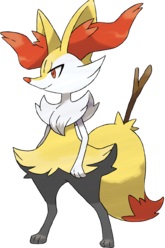 So, here we are again, with the second new batch of Pokémon introduced via semi-anthropomorphic fox; while Zorua and Zoroark got that honor last time, this time the new starter Pokémon, including Fire starter Fennekin, were the first glimpse at the new Pokémon. And, okay, Fennekin doesn’t exactly start out even semi-anthropomorphic, middle evolution Braixen evolves a mini-skirt (regardless of gender, of course) while final evolution Delphox goes for something a bit more modest (and slightly less gender specific).
So, here we are again, with the second new batch of Pokémon introduced via semi-anthropomorphic fox; while Zorua and Zoroark got that honor last time, this time the new starter Pokémon, including Fire starter Fennekin, were the first glimpse at the new Pokémon. And, okay, Fennekin doesn’t exactly start out even semi-anthropomorphic, middle evolution Braixen evolves a mini-skirt (regardless of gender, of course) while final evolution Delphox goes for something a bit more modest (and slightly less gender specific).
If for some odd reason you’re a furry who doesn’t like foxes in mini-skirts (I guess it’s possible, but please explain yourself in the comments), well, you’ve also got the Water starter Froakie who turns into a frog ninja Greninja. That’s just the starters, and with those two, we’ve already got the furriest set of starters pretty much ever (though the Grass starter manages to be fairly non-anthropomorphic despite becoming more-likely-to-drop-the-animal-than-anthropomorphic Fighting type, as well as pretty lame, actually). So, that should make furries excited.
But does the game add anything to the formula? Well, this is one of the most radical overhauling of the basic framework of the Pokémon games since at least the second generation. Most of this new stuff works, but there are some issues as well.
Review: 'Teenage Mutant Ninja Turtles: The Ultimate Visual History', by Andrew Farago.
Posted by Fred on Wed 6 Aug 2014 - 02:29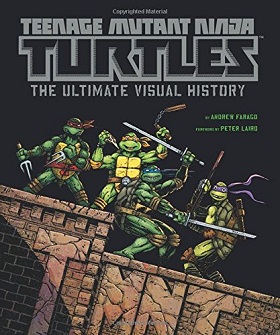 This large, full-color book is published both for the 30th anniversary of the Teenage Mutant Ninja Turtles comic book, which was first published by two comic-book fans at a comics convention in Portsmouth, New Hampshire in May 1984, and for the release of the fifth Teenage Mutant Ninja Turtles theatrical feature opening this Friday.
This large, full-color book is published both for the 30th anniversary of the Teenage Mutant Ninja Turtles comic book, which was first published by two comic-book fans at a comics convention in Portsmouth, New Hampshire in May 1984, and for the release of the fifth Teenage Mutant Ninja Turtles theatrical feature opening this Friday.
This is one of those “all you want to know about” books. It is not so much about the characters themselves as it is the official history of the TMNT phenomenon, or franchise, or whatever you want to call it. Kevin Eastman and Peter Laird, the TMNT’s creators, are collectors as much as anything else, and this book is full of original sketches, the flyer for that 1984 comics convention, comic book covers, storyboards and cels from the TV animated series, posters and stills from the theatrical features, photos of all the TMNT merchandising items and so on.
Personally, I would have preferred more profiles of the anthropomorphic supporting characters besides Splinter the rat sensei, such as Bebop the warthog, Ninjara the vixen, or Dogpound and Fishface, who are not described because, with names like that, who needs to? Or plot synopses of the stories in the comic books, the TV series (or selected episodes; I suppose that asking for a synopsis of every TV episode would be too much), and the theatrical features.
Foreword by Peter Laird, San Rafael CA, Insight Editions, June 2014, hardcover $50.00 (192 pages).
Video: 'Inherit the Earth: Sand and Shadows' demo
Posted by wyrmkeep on Thu 7 Aug 2014 - 23:18The Wyrmkeep Entertainment Co. has released a short demo video of their adventure game Inherit the Earth: Sand and Shadows that is currently in development.
Review: 'Teenage Mutant Ninja Turtles' Ultimate Showdown DVD, Disc 1
Posted by crossaffliction on Thu 7 Aug 2014 - 23:41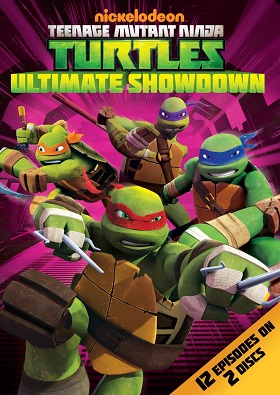 This is actually a two disc collection of the back half of season 1 of the Nickelodeon Teenage Mutant Ninja Turtles series. I’m breaking them up into to two reviews, one for each disc, so that it doesn’t break the around six-ish episode streak of each review.
This is actually a two disc collection of the back half of season 1 of the Nickelodeon Teenage Mutant Ninja Turtles series. I’m breaking them up into to two reviews, one for each disc, so that it doesn’t break the around six-ish episode streak of each review.
If you’d like to check out reviews of the rest of the first season, you can read the first seven episodes reviewed here, and the second six reviewed here, plus an extended review of the first two episodes (or one long episode, the series still isn’t clear on that) here. In fact, you should probably read that last linked article first, seeing as how it’s both the first chronologically and it also has breakdown of what this series is about.
You know, just in case the series title Teenage Mutant Ninja Turtles didn’t clue you in that it’s about turtles, who are also ninjas, mutants and teenagers.
The Episodes
“I, Monster”
And we start off with one of the best episodes of the series, with the weird penchant for horror tropes and allusions finally given an episode where they fit like a glove. Dr. Falco (Jeffrey Combs) continues his experiments with the mutagen, but a lab accident turns him into the Rat King, with the ability to control all rats, and the turtles come to a horrifying realization; Splinter’s been taking it easy on them in training.
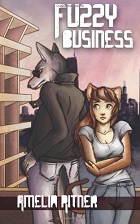 Miara is a humanimal, a woman just like anyone else, except with feline features and some feline abilities … (blurb)
Miara is a humanimal, a woman just like anyone else, except with feline features and some feline abilities … (blurb)